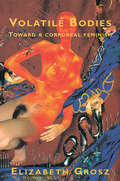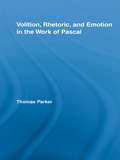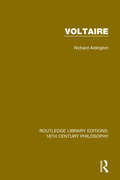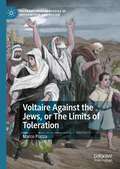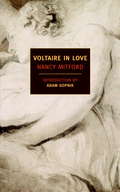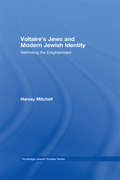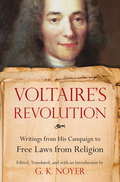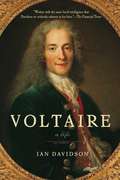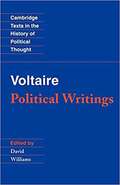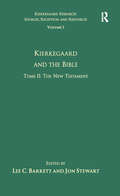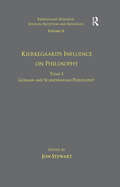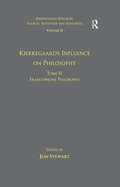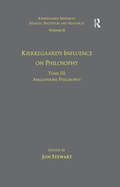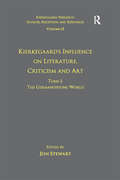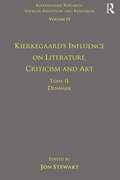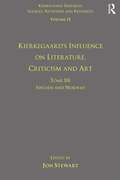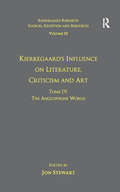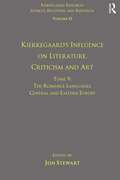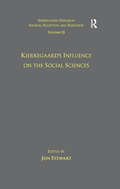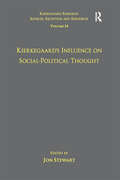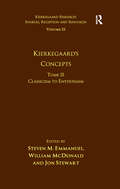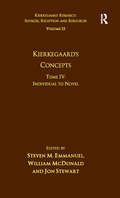- Table View
- List View
Volatile Bodies: Toward A Corporeal Feminism (Theories Of Representation And Difference Ser.)
by Elizabeth GroszVolatile Bodies is based on a risky wager: that all the effects of subjectivity, psychological depth and inferiority can be refigured in terms of bodies and surfaces. It uses, transforms and subverts the work of a number of distinguished male theorists of the body (Freud, Lacan, Merleau-Ponty, Schilder, Nietzsche, Foucault, Lingis and Deleuze) who, while freeing the body from its subordination to the mind, are nonetheless unable to accomodate the specificities of women's bodies. Volatile Bodies explores various dissonances in thinking the relation between mind and body. It investigates issues that resist reduction to these binary terms - psychosis, hypochondria, neurological disturbances, perversions and sexual deviation - and most particularly the enigmatic status of body fluids, and the female body.
Volition, Rhetoric, and Emotion in the Work of Pascal
by Thomas ParkerThis study identifies and analyzes a compelling theory and practice of persuasion that integrates the complexity of human desire. It demonstrates how the philosophical component in Pascal's description of the will makes a seamless integration into a vehicle of persuasion and poetics, providing a privileged viewpoint for understanding the author's complete works, arguing that the notion of will is of fundamental importance in Pascal's anthropology as well as in his rhetoric. This avenue of interpretation is both fruitful and difficult, because the word "volonte" means very different things in Pascal and in modern French. Beginning by contextualizing the notion of 'volonte' and explaining its expanded use in the seventeenth-century lexicon, the author then endeavors to show that Pascal borrows an essentially Augustinian paradigm of desire to create a depiction of the will divided against itself, surreptitiously yearning for what its bearer does not want.
Voltaire (Routledge Library Editions: 18th Century Philosophy #17)
by Richard AldingtonThis book, first published in 1929, is an assessment of Voltaire’s life and works. It contains valuable biographical details, as well as studies of his works, philosophy, poetry, plays and literary criticism.
Voltaire Against the Jews, or The Limits of Toleration (Palgrave Critical Studies of Antisemitism and Racism)
by Marco PiazzaThis book challenges Voltaire’s doctrine of toleration. Can a Jew be a philosopher? And if so, at what cost? It seeks to provide an organic interpretation of Voltaire’s attitude towards Jews, problematising the issue against the background of his theory of toleration. To date, no monograph entirely dedicated to this theme has been written. This book attempts to provide an answer to the crucial questions that have emerged in the past fifty years through a process of reading and analysis that starts with the publication of Des Juifs (1756), and ends with the posthumous publication of the apocryphal article ‘Juifs’ in the Kehl edition of the Dictionnaire Philosophique (1784).
Voltaire in Love
by Nancy Mitford Adam GopnikThe inimitable Nancy Mitford's account of Voltaire's fifteen-year relationship with the Marquise du Châtelet--the renowned mathematician who introduced Isaac Newton's revolutionary new physics to France--is a spirited romp in the company of two extraordinary individuals as well as an erudite and gossipy guide to French high society during the Enlightenment. Mitford's story is as delicious as it is complicated. The marquise was in love with another mathematician, Maupertuis, while she had an unexpected rival for Voltaire's affections in the future Frederick the Great of Prussia (and later in the philosophe's own niece). There was, at least, no jealous husband to contend with: the Marquis du Châtelet, Mitford assures us, behaved perfectly. The beau monde of Paris was, however, distraught at the idea of the lovers' brilliant conversation going to waste on the windswept hills of Champagne, site of the Château de Cirey, where experimental laboratories, a darkroom, and a library of more than twenty-one thousand volumes enabled them to pursue their amours philosophiques. From time to time the threat of impending arrest would send Voltaire scurrying across the border into Holland, but his irrepressible charm--and the interventions of powerful friends--always made it possible for him resume his studies with the cherished marquise.
Voltaire's Bastards: The Dictatorship Of Reason In The West
by John Ralston SaulVoltaire's Bastards: The Dictatorship of Reason in the West is a sweeping and provocative exploration of nothing less than the political, economic, social, and cultural origins of Western society. With great daring and originality, John Ralston Saul dissects the contradictions, delusions, and illusions that have brought the world to the brink of confusion and crisis, and shatters the myths surrounding the icons and institutions that we have been taught to revere and cherish.
Voltaire's Jews and Modern Jewish Identity: Rethinking the Enlightenment (Routledge Jewish Studies Series #Vol. 27)
by Harvey MitchellHarvey Mitchell’s book argues that a reassessment of Voltaire’s treatment of traditional Judaism will sharpen discussion of the origins of, and responses to, the Enlightenment. His study shows how Voltaire’s nearly total antipathy to Judaism is best understood by stressing his self-regard as the author of an enlightened and rational universal history, which found Judaism’s memory of its past incoherent, and, in addition, failed to meet the criteria of objective history—a project in which he failed. Calling on an array of Jewish and non-Jewish figures to reveal how modern interpretations of Judaism may be traced to the core ideas of the Enlightenment, this book concludes that Voltaire paradoxically helped to foster the ambiguities and uncertainties of Judaism’s future.
Voltaire's Revolution
by G. K. NoyerVoltaire, the pen name of François-Marie Arouet (1694-1778), was one of the most influential leaders of the French Enlightenment. His defense of individual freedom of conscience and his criticisms of religious fanaticism and oppressive orthodoxy had a telling effect on Western history, inspiring several leading founders of America's new laws.This is the first English translation of many of his key texts from his famous pamphlet war for tolerance, written from 1750 to 1768, originally published under pseudonyms to avoid imprisonment and to educate the average citizen. Included are "The Sermon of Rabbi Akib" (a searing attack on anti-Semitism), "Prayer to God" (from the famous Treatise on Tolerance), the hugely popular "Catechism of the Honest Man," "The Dinner at Count Boulainvillier's," and other witty, sometimes acerbic pieces that point out the errors in the Bible, the corruption of the clergy, and the religiously-inspired persecutions, both of his day and across the ages. Many of these pamphlets were burned in a losing battle by the authorities.With a lengthy introduction and copious notes by the editor and translator, plus an appendix including first-hand accounts of the battle by noted mathematician and French revolutionary Condorcet, Frederick the Great, Irish writer Oliver Goldsmith, and others, this excellent compilation will be a welcome addition to the libraries of anyone with an interest in human rights and freedom of thought.From the Trade Paperback edition.
Voltaire: A Life
by Ian DavidsonThe definitive biography of Voltaire's life -- from his scandalous love affairs and political maneuverings to his inspired philosophy. We think of Voltaire as the archetypal figure of the enlightenment; in his own time he was also the most famous and controversial figure in Europe. This dazzling new biography celebrates his extraordinary life. Davidson tells the whole, rich story of Voltaire's life (1694-1778): his early imprisonment in the Bastille; exile in England and his mastery of English; an obsession with money, of which he made a huge amount; a scandalous love life; a long exile on the borders of Switzerland; his human-rights campaigns and his triumphant return to Paris to die there as celebrity extraordinaire. Throughout all of this, Voltaire's life was always informed by two things: a belief in the essential value of toleration in the face of fanaticism; and in the right of every man to think and say what he liked. It is rare to have such a vivid portrait of a great man.
Voltaire: Political Writings (Cambridge Texts In The History Of Political Thought)
by Voltaire David Williams Quentin Skinner Raymond GeussThis edition of Voltaire's political writings presents a varied selection of his most interesting and controversial texts, many of which have not previously been translated into English. Their themes include the nature and legitimacy of political power, law and the social order, and the growing disorder in the French economy, and in addition they touch on specific issues such as the Seven Years' War and relations with Frederick II, and the sensational trials of Jean Calas, Sirver and the Chevalier De La Barre.
Volume 1, Tome I: The New Testament (Kierkegaard Research: Sources, Reception and Resources)
by Jon StewartExploring Kierkegaard's complex use of the Bible, the essays in this volume use source-critical research and tools ranging from literary criticism to theology and biblical studies, to situate Kierkegaard's appropriation of the biblical material in his cultural and intellectual context. The contributors seek to identify the possible sources that may have influenced Kierkegaard's understanding and employment of Scripture, and to describe the debates about the Bible that may have shaped, perhaps indirectly, his attitudes toward Scripture. They also pay close attention to Kierkegaard's actual hermeneutic practice, analyzing the implicit interpretive moves that he makes as well as his more explicit statements about the significance of various biblical passages. This close reading of Kierkegaard's texts elucidates the unique and sometimes odd features of his frequent appeals to Scripture. This volume in the series devotes one tome to the Old Testament and a second tome to the New Testament. Tome I considers the canonically disputed literature of the Apocrypha. Although Kierkegaard certainly cited the Old Testament much less frequently than he did the New, passages and themes from the Old Testament do occupy a position of startling importance in his writings. Old Testament characters such as Abraham and Job often play crucial and even decisive roles in his texts. Snatches of Old Testament wisdom figure prominently in his edifying literature. The vocabulary and cadences of the Psalms saturate his expression of the range of human passions from joy to despair. The essays in this first tome seek to elucidate the crucial rhetorical uses to which he put key passages from the Old Testament, the sources that influenced him to do this, and his reasons for doing so.
Volume 1, Tome II: The New Testament (Kierkegaard Research: Sources, Reception and Resources)
by Lee C. BarrettExploring Kierkegaard's complex use of the Bible, the essays in this volume use source-critical research and tools ranging from literary criticism to theology and biblical studies, to situate Kierkegaard's appropriation of the biblical material in his cultural and intellectual context. The contributors seek to identify the possible sources that may have influenced Kierkegaard's understanding and employment of Scripture, and to describe the debates about the Bible that may have shaped, perhaps indirectly, his attitudes toward Scripture. They also pay close attention to Kierkegaard's actual hermeneutic practice, analyzing the implicit interpretive moves that he makes as well as his more explicit statements about the significance of various biblical passages. This close reading of Kierkegaard's texts elucidates the unique and sometimes odd features of his frequent appeals to Scripture. This volume in the series devotes one tome to the Old Testament and a second tome to the New Testament. As with the Old Testament, Kierkegaard was aware of new developments in New Testament scholarship, and troubled by them. Because these scholarly projects generated alternative understandings of the significance of Jesus, they impinged directly on his own work. It was crucial for Kierkegaard that Jesus is presented as both the enactment of God's reconciliation with humanity and as the prototype for humanity to emulate. Consequently, Kierkegaard had to struggle with the proper way to explicate persuasively the significance of Jesus in a situation of decreasing academic consensus about Jesus. He also had to contend with contested interpretations of James and Paul, two biblical authors vital for his work. As a result, Kierkegaard ruminated about the proper way to appropriate the New Testament and used material from it carefully and deliberately. The authors in the present New Testament tome seek to clarify different dimensions of Kierkegaard's interpretive theory and practice as he sought to avoid the twin pitfalls of academic skepticism and passionless biblical traditionalism.
Volume 11, Tome I: German and Scandinavian Philosophy (Kierkegaard Research: Sources, Reception and Resources)
by Jon StewartKierkegaard's relation to the field of philosophy is a particularly complex and disputed one. He rejected the model of philosophical inquiry that was mainstream in his day and was careful to have his pseudonymous authors repeatedly disassociate themselves from philosophy. But although it seems clear that Kierkegaard never regarded himself as a philosopher, there can be no doubt that his writings contain philosophical ideas and insights and have been profoundly influential in a number of different philosophical traditions. The present volume documents these different traditions of the philosophical reception of Kierkegaard's thought and the articles featured demonstrate the vast reach of Kierkegaard's writings in philosophical contexts that were often quite different from his own. Tome I is dedicated to exploring the reception of Kierkegaard in Germanophone and Scandinavian philosophy. Kierkegaard has been a major influence for such different philosophical projects as phenomenology, hermeneutics, dialogical thinking, critical theory, Marxism, logical positivism and ordinary language philosophy. Similarly in Denmark and Norway Kierkegaard's writings have been more or less constantly discussed by important philosophers, despite the later dominance of analytic philosophy in these countries. The present tome features articles on the leading Germanophone and Scandinavian philosophers influenced by Kierkegaard's thought.
Volume 11, Tome II: Francophone Philosophy (Kierkegaard Research: Sources, Reception and Resources)
by Jon StewartKierkegaard's relation to the field of philosophy is a particularly complex and disputed one. He rejected the model of philosophical inquiry that was mainstream in his day and was careful to have his pseudonymous authors repeatedly disassociate themselves from philosophy. But although it seems clear that Kierkegaard never regarded himself as a philosopher, there can be no doubt that his writings contain philosophical ideas and insights and have been profoundly influential in a number of different philosophical traditions. The tomes in this volume seek to document the different traditions of the philosophical reception of Kierkegaard's thought and the articles demonstrate the reach of Kierkegaard's writings in philosophical contexts that were often different from his own. The present volume attempts to document these different traditions of the philosophical reception of Kierkegaard's thought. The articles featured here aim to demonstrate the vast reach of Kierkegaard's writings in philosophical contexts that were often quite different from his own. Tome II is dedicated to exploring Kierkegaard's influence on Francophone philosophy. The French intellectual tradition squares well with Kierkegaard's eclectic profile since its leading figures are often difficult to classify unambiguously as philosophers, theologians, literary critics or simply writers. Kierkegaard's thinking was highly influential for many generations of French philosophers right up to the present. It was not just existentialism that tried to co-opt Kierkegaard for its own purposes; he has also been influential in the context of almost every modern school of French thought: phenomenology, feminism, structuralism, post-structuralism, semiotics, and deconstruction.
Volume 11, Tome III: Anglophone Philosophy (Kierkegaard Research: Sources, Reception and Resources)
by Jon StewartKierkegaard's relation to the field of philosophy is a particularly complex and disputed one. He rejected the model of philosophical inquiry that was mainstream in his day and was careful to have his pseudonymous authors repeatedly disassociate themselves from philosophy. But although it seems clear that Kierkegaard never regarded himself as a philosopher, there can be no doubt that his writings contain philosophical ideas and insights and have been profoundly influential in a number of different philosophical traditions.The present volume attempts to document these different traditions of the philosophical reception of Kierkegaard's thought. Tome III traces Kierkegaard's influence on Anglophone philosophy. It has long been thought that Kierkegaard played no role in this tradition, which for years was dominated by analytic philosophy. In this environment it was common to dismiss Kierkegaard along with the then current European philosophers who were influenced by him. However, a closer look reveals that in fact there were several thinkers in the US, Canada and Great Britain who were inspired by Kierkegaard even during the heyday of analytic philosophy. Today it can be said that Kierkegaard has made some serious inroads into mainstream Anglophone philosophy, with many authors seeking inspiration in his works for current discussions concerning ethics, personal identity, philosophy of religion, and philosophical anthropology.
Volume 12, Tome I: The Germanophone World (Kierkegaard Research: Sources, Reception and Resources)
by Jon StewartWhile Kierkegaard is primarily known as a philosopher or religious thinker, his writings have also been used extensively by literary writers, critics and artists worldwide who have been attracted to his creative mixing of genres, his complex use of pseudonyms, his rhetoric and literary style, and his rich images, parables, and allegories. The goal of the present volume is to document this influence in different language groups and traditions. Tome I explores Kierkegaard’s influence on literature and art in the Germanophone world. He was an important source of inspiration for German writers such as Theodor Fontane, Thomas Mann, Rainer Maria Rilke, Alfred Andersch, and Martin Walser. Kierkegaard’s influence was particularly strong in Austria during the generation of modernist authors such as Rudolf Kassner, Karl Kraus, Robert Musil, and Hermann Broch. Due presumably in part to the German translations of Kierkegaard in the Austrian cultural journal Der Brenner, Kierkegaard continued to be used by later figures such as the novelist and playwright, Thomas Bernhard. His thought was also appropriated in Switzerland through the works of Max Frisch and Friedrich Dürrenmatt. The famous Czech author Franz Kafka identified personally with Kierkegaard’s love story with Regine Olsen and made use of his reflections on this and other topics.
Volume 12, Tome II: Denmark (Kierkegaard Research: Sources, Reception and Resources)
by Jon StewartWhile Kierkegaard is primarily known as a philosopher or religious thinker, his writings have also been used extensively by literary writers, critics and artists worldwide who have been attracted to his creative mixing of genres, his complex use of pseudonyms, his rhetoric and literary style, and his rich images, parables, and allegories. The goal of the present volume is to document this influence in different language groups and traditions. Tome II is dedicated to the use of Kierkegaard by later Danish writers. Almost from the beginning Kierkegaard’s works were standard reading for these authors. Danish novelists and critics from the Modern Breakthrough movement in the 1870s were among the first to make extensive use of his writings. These included the theoretical leader of the movement, the critic Georg Brandes, who wrote an entire book on Kierkegaard, and the novelists Jens Peter Jacobsen and Henrik Pontoppidan. The next generation of writers from the turn of the century and through the First World War also saw in Kierkegaard important points of inspiration. These included Ernesto Dalgas and Harald Kidde, who used elements of Kierkegaard’s thought in their novels. Modern Danish writers such as Karen Blixen, Martin A. Hansen, and Villy Sørensen have continued to incorporate Kierkegaard into their works. There can be no doubt that Kierkegaard has indelibly stamped his name on Danish literature.
Volume 12, Tome III: Sweden and Norway (Kierkegaard Research: Sources, Reception and Resources)
by Jon StewartWhile Kierkegaard is primarily known as a philosopher or religious thinker, his writings have also been used extensively by literary writers, critics and artists. This use can be traced in the work of major cultural figures not just in Denmark and Scandinavia but also in the wider world. They have been attracted to his creative mixing of genres, his complex use of pseudonyms, his rhetoric and literary style, and his rich images, parables and allegories. The present volume documents this influence in the different language groups and traditions. Tome III investigates the works of Swedish and Norwegian writers and artists inspired by Kierkegaard. In Sweden the novelist Victoria Benedictsson made use of Kierkegaard during the period of the so-called Modern Breakthrough, as did the playwright August Strindberg. Later Swedish writers have continued to draw on his thought, such as Selma Lagerlof, Lars Ahlin, Lars Gyllensten, and Carl-Henning Wijkmark. The Norwegian reception of Kierkegaard also began remarkably early and was shaped by the leading names in Norwegian cultural life. Despite his coy responses to questions about his relation to Kierkegaard, Henrik Ibsen clearly seems to have been inspired by the Dane in works such as Brand. Norwegian writer and poet Bjornstjerne Bjornson, who was influenced by the Modern Breakthrough movement, was also deeply inspired by Kierkegaard. Finally, the celebrated Norwegian artist Edvard Munch (1863-1944) closely studied key Kierkegaardian concepts such as anxiety, and his influence is notable in his iconic paintings such as The Scream.
Volume 12, Tome IV: The Anglophone World (Kierkegaard Research: Sources, Reception and Resources)
by Jon StewartWhile Kierkegaard is primarily known as a philosopher or religious thinker, his writings have also been used extensively by literary writers, critics and artists. This use can be traced in the work of major cultural figures not just in Denmark and Scandinavia but also in the wider world. They have been attracted to his creative mixing of genres, his complex use of pseudonyms, his rhetoric and literary style, and his rich images, parables, and allegories. The present volume documents this influence in the different language groups and traditions. Tome IV examines Kierkegaard’s surprisingly extensive influence in the Anglophone world of literature and art, particularly in the United States. His thought appears in the work of the novelists Walker Percy, James Baldwin, Flannery O’Connor, William Styron, Don Delillo, and Louise Erdrich. He has also been used by the famous American literary critics, George Steiner and Harold Bloom. The American composer Samuel Barber made use of Kierkegaard in his musical works. Kierkegaard has also exercised an influence on British and Irish letters. W.H. Auden sought in Kierkegaard ideas for his poetic works, and the contemporary English novelist David Lodge has written a novel Therapy, in which Kierkegaard plays an important role. Cryptic traces of Kierkegaard can also be found in the work of the famous Irish writer James Joyce.
Volume 12, Tome V: The Romance Languages, Central and Eastern Europe (Kierkegaard Research: Sources, Reception and Resources)
by Jon StewartWhile Kierkegaard is primarily known as a philosopher or religious thinker, his writings have also been used extensively by literary writers, critics and artists. This use can be traced in the work of major cultural figures not just in Denmark and Scandinavia but also in the wider world. They have been attracted to his creative mixing of genres, his complex use of pseudonyms, his rhetoric and literary style, and his rich images, parables, and allegories. The present volume documents this influence in the different language groups and traditions. Tome V treats the work of a heterogeneous group of writers from the Romance languages and from Central and Eastern Europe. Kierkegaard has been particularly important for Spanish literature: the Argentine writers Jorge Luis Borges, Leonardo Castellani, and Ernesto Sábato, the Mexican writer Carlos Fuentes, and the Spanish essayist and philosopher MarÃa Zambrano were all inspired to varying degrees by him. The Dane also appears in the work of Romanian writer Max Blecher, while the Portuguese author Fernando Pessoa was almost certainly inspired by Kierkegaard’s use of pseudonyms. Kierkegaard has also influenced diverse literary figures from Central and Eastern Europe. His influence appears in the novels of the contemporary Hungarian authors Péter Nadas and Péter Esterházy, the work of the Russian writer and literary critic, Mikhail Bakhtin, the Polish writer Witold Gombrowicz and the Czech novelist Ivan KlÃma. Tome V also examines how Kierkegaard’s treatment of the story of Abraham and Isaac in Fear and Trembling interested the Polish-born Israeli novelist Pinhas Sadeh.
Volume 13: Kierkegaard's Influence on the Social Sciences (Kierkegaard Research: Sources, Reception and Resources)
by Jon StewartKierkegaard has long been known as a philosopher and theologian, but his contributions to psychology, anthropology and sociology have also made an important impact on these fields. In many of the works of his complex authorship, Kierkegaard presents his intriguing and unique vision of the nature and mental life of human beings individually and collectively. The articles featured in the present volume explore the reception of Kierkegaard's thought in the social sciences. Of these fields Kierkegaard is perhaps best known in psychology, where The Concept of Anxiety and The Sickness unto Death have been the two most influential texts. With regard to the field of sociology, social criticism, or social theory, Kierkegaard's Literary Review of Two Ages has also been regarded as offering valuable insights about some important dynamics of modern society..
Volume 14: Kierkegaard's Influence on Social-Political Thought (Kierkegaard Research: Sources, Reception and Resources)
by Jon StewartWhile scholars have long recognized Kierkegaard's important contributions to fields such as ethics, aesthetics, philosophy of religion, philosophical psychology, and hermeneutics, it was usually thought that he had nothing meaningful to say about society or politics. Kierkegaard has been traditionally characterized as a Christian writer who placed supreme importance on the inward religious life of each individual believer. His radical view seemed to many to undermine any meaningful conception of the community, society or the state. In recent years, however, scholars have begun to correct this image of Kierkegaard as an apolitical thinker. The present volume attempts to document the use of Kierkegaard by later thinkers in the context of social-political thought. It shows how his ideas have been employed by very different kinds of writers and activists with very different political goals and agendas. Many of the articles show that, although Kierkegaard has been criticized for his reactionary views on some social and political questions, he has been appropriated as a source of insight and inspiration by a number of later thinkers with very progressive, indeed, visionary political views.
Volume 15, Tome II: Classicism to Enthusiasm (Kierkegaard Research: Sources, Reception and Resources)
by Steven M. Emmanuel William McDonaldKierkegaard’s Concepts is a comprehensive, multi-volume survey of the key concepts and categories that inform Kierkegaard’s writings. Each article is a substantial, original piece of scholarship, which discusses the etymology and lexical meaning of the relevant Danish term, traces the development of the concept over the course of the authorship, and explains how it functions in the wider context of Kierkegaard’s thought. Concepts have been selected on the basis of their importance for Kierkegaard’s contributions to philosophy, theology, the social sciences, literature and aesthetics, thereby making this volume an ideal reference work for students and scholars in a wide range of disciplines.
Volume 15, Tome III: Envy to Incognito (Kierkegaard Research: Sources, Reception and Resources)
by Steven M. Emmanuel William McDonaldKierkegaard’s Concepts is a comprehensive, multi-volume survey of the key concepts and categories that inform Kierkegaard’s writings. Each article is a substantial, original piece of scholarship, which discusses the etymology and lexical meaning of the relevant Danish term, traces the development of the concept over the course of the authorship, and explains how it functions in the wider context of Kierkegaard’s thought. Concepts have been selected on the basis of their importance for Kierkegaard’s contributions to philosophy, theology, the social sciences, literature and aesthetics, thereby making this volume an ideal reference work for students and scholars in a wide range of disciplines.
Volume 15, Tome IV: Individual to Novel (Kierkegaard Research: Sources, Reception and Resources)
by Jon Stewart Steven M. Emmanuel William McDonaldKierkegaard’s Concepts is a comprehensive, multi-volume survey of the key concepts and categories that inform Kierkegaard’s writings. Each article is a substantial, original piece of scholarship, which discusses the etymology and lexical meaning of the relevant Danish term, traces the development of the concept over the course of the authorship, and explains how it functions in the wider context of Kierkegaard’s thought. Concepts have been selected on the basis of their importance for Kierkegaard’s contributions to philosophy, theology, the social sciences, literature and aesthetics, thereby making this volume an ideal reference work for students and scholars in a wide range of disciplines.
